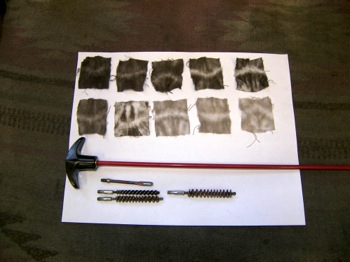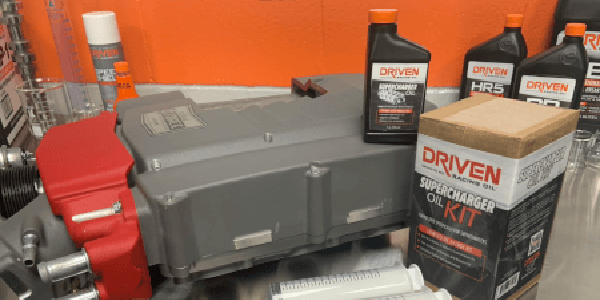Authors of Shop Solutions published in each issue of Engine Builder Magazine are awarded a prepaid $100 Visa gift card. Shop Solutions may also be submitted to [email protected].
A Better Way to Clean Oil Galleries
 I’ve always used the standard long handled nylon bristle brushes dipped in solvent to scrub the oil galleries in blocks, heads and cranks before assembly. However, while cleaning a gun bore, it occurred to me that I didn’t really know how clean the galleries were actually getting in the engines that I build. The patches used in cleaning gun bores give a very definitive visual of exactly how clean the bore is.
I’ve always used the standard long handled nylon bristle brushes dipped in solvent to scrub the oil galleries in blocks, heads and cranks before assembly. However, while cleaning a gun bore, it occurred to me that I didn’t really know how clean the galleries were actually getting in the engines that I build. The patches used in cleaning gun bores give a very definitive visual of exactly how clean the bore is.
I decided to try this method of cleaning on the next engine that I built, which was a 1928 Dodge flathead four cylinder. I started by cleaning the block like I always do: thermally process in an oven, run through an airless shotblaster, wash twice in an aqueous jet washing machine (once before machining and then again after), and finally run a cleaning brush with solvent through each gallery several times.
After this, I got the gun cleaning equipment out and ran patches soaked with the same solvent through the main gallery. The results can be seen in the attached picture. Obviously, my cleaning method was not actually getting the galleries clean! Up close inspection of the patches revealed rust, grime and small shiny metal particles that were not removed by my standard cleaning regimen. This junk would certainly make its way to the bearings, especially with modern detergent oils and higher than stock oil pressure.
It takes a few more minutes than my old method, but now I know the galleries are actually getting clean. Gun cleaning rods, patches and brushes in a variety of sizes, (0.177˝ – 0.729˝ are commonly available, although you will need a couple of different cleaning rods to span that range) can be obtained from a local sporting goods store for very little expense.
Tony Smith
Gunsmith/Machinist/Engine Builder
Lewistown, MT
Get Organized!
Looking around for tools and parts wastes a lot of time and money. There is a great benefit to being
organized and having the tools you need where you need them. Our head resurfacer for instance used to have a roll cart next to it piled with adapters, shims, washers and wrenches.
Every time you had to cut a head, you had to dig through to find what you needed. Simple peg board and a shelf made those tools easily accessible and the job is a breeze now. This is true for every part of your shop, from how you handle you paperwork to the procedures of rebuilding heads. If there are procedures in place and you are organized, the jobs flow through much faster.
Once the tried and true procedures are in place, every employee must follow them so that one can pick up where the other left off without wondering if certain steps have been done. We’ve been more organized with procedures and shop cleanliness for six years, and jobs breeze through our shop now with no problem.
Jeffrey Myers
MAR Automotive Inc
Philadelphia, PA
iPad, Do You?
The next piece of electronics for your shop might be an iPad or something comparable. I hear that some guys are even trying to handle parts purchasing from their smart phones. Leave the phone for talking. A tablet or iPad could be used for many things around the shop and is very portable. It could be used for e-mailing customers and suppliers, or you can access the internet and place orders online with suppliers that offer this service.
You can use the “Notes” application as a running tab of parts to acquire or jobs that need to be accomplished. Use the built-in camera to send pictures to suppliers or customers. Use the internet search engines to find info on jobs you may not be familiar with while you’re at the workbench or machine working on it. I believe it might be possible in the future for you to access your own business software through your iPad from the furthest reaches of your shop or even from home.
Dave Sutton
Sterling Bearing Inc
Minneapolis, MN
Making Your Own Custom Wrench for Headers
For starters, find an old wrench you will not feel bad about bending and manipulating into the desired handle configuration. Then, I recommend a new sparkplug socket. (Make sure the wrench you choose will butt up to the socket.) Take the sparkplug socket and cut the end of the socket where the ratchet normally would hook to socket. Now take your wrench and the half cut socket and either tig weld or mig weld together. Bend the wrench in the desired position to make the removal and installation of your sparkplugs easier.
The amount of socket you cut off is entirely up to you and your application. When done, the end of the sparkplug should be able to go all the way through to the end of the socket and fit in just about any
location.
Roy Maloney
Engine & Performance Warehouse
Houston, TX
Fuel System Corrosion Issues in Rarely Driven Vehicles
The use of ethanol in modern gasoline has brought with it (among other things) the problem of corrosion in fuel systems, especially in seldom used older vehicles. Carburetors are especially vulnerable to ethanol corrosion.
Drawing a line in the sand, if an older vehicle is carbureted, uses less than one tankful of fuel containing some ethanol every two to three weeks, especially if it is stored in a humid environment, it is a prime candidate for fuel system corrosion problems.
The problem is that Ethanol is hygroscopic, meaning it absorbs moisture. It is corrosive to the entire fuel system, especially carburetors, and ethanol dilution in motor oil leads to increased moisture in the crankcase, causing rust and other corrosion problems. Most new vehicle fuel systems are constructed with materials that resist damage from the current E10 (10%) ethanol mixture. This is not the case with older cars and cars with specialty performance parts.
Recently, the Environmental Protection Agency (EPA) has permitted the sale of fuel containing E15 (15% ethanol). This will make the problem significantly worse. Organizations such as SEMA are taking this decision all the way to the U.S. Supreme Court.
If your or your customer’s vehicle fits the description in the first paragraph, you should strongly consider using a fuel additive containing corrosion inhibitors such as “Carb Defender.”
And write to your congressman!
Engine Pro Technical Dept.
With thanks to Lake Speed, Jr.
Driven Racing Oil
Factoid of the Month: The Engine of the Future
How accurate were predictions of 50 years ago about what would power the car of the future? The answer is: not very. An article in the Summer 1962 issue of Automobile Quarterly magazine predicted the dominant motive power in the future would be the gas turbine engine.
It also predicted the internal combustion engine would be less popular but still be around. The article went on to describ a revolutionary new design by U.S. Steel for an engine made primarily of stainless and carbon steel stampings (because you know the folks at U.S. Steel wouldn’t design an engine made out of aluminum or soybeans). It is hard to picture this, but the block and cylinders would be stamped from stainless steel and the connecting rods would be stamped from carbon steel.
This stamped steel engine was never produced. Possibly people still remembered all the problems Powel Crosley, Jr, had a few years before with the COBRA (copper brazed) block made from stamped steel sheets in his little car. What was Mr. Crosley’s solution to his engine problems? A cast iron block.
Engine Builder Shop Solutions is sponsored by Engine Pro, a group of 9 engine parts specialist WDs in the U.S., and one in Australia, operating 35 branch locations serving engine builders/rebuilders across the U.S and Australia. Authors of Shop Solutions published in each issue of Engine Builder Magazine are awarded a prepaid $100 Visa gift card. Entries will be chosen by the staff of Engine Builder Magazine and the Engine Pro Technical Committee.
To submit a Shop Solution simply mail your entry to Engine Builder Magazine, Shop Solutions, 3550 Embassy Parkway, Akron, OH 44333; or email to [email protected]. Shop Solutions may also be emailed to [email protected].
You must include your name, shop name, shop address and shop telephone number. Submitted Shop Solutions not published will be kept on file and reevaluated for publication with each month’s new entries. If you include your email address you will be emailed notification of publication if your Shop Solution is chosen














